Are you a Quiet Speculation member?
If not, now is a perfect time to join up! Our powerful tools, breaking-news analysis, and exclusive Discord channel will make sure you stay up to date and ahead of the curve.
Welcome back, readers!
Today's article addresses something that we all know, but which is easy to pass over and forget: The main determinant of a card's price is its power level---or how "good" it is.
As financiers and speculators, we pay close attention to many factors that affect prices, like rotation, reprints, deck techs and buyouts. We closely monitor the prices themselves as well. No doubt many of you could cite the most expensive cards in a given Standard set (Shadows over Innistrad, say) off the top of your head.
We tend to assume these prices reflect power level, or how "good" the cards are in a competitive context. If Arlinn Kord // Arlinn, Embraced by the Moon is cheap and Archangel Avacyn // Avacyn, the Purifier is expensive, it must be because the latter is a better card.
What's important to remember is that while the objective price of a card is set by the market, that doesn't mean the market is correct in its evaluation of the card's intrinsic value. When you look at a card's current price and decide that you believe the market is wrong, and that the price doesn't reflect the real value, you're engaging in true speculation. This is where the real money in MTG finance is to be made.
After all, we all know the difficulties involved in waiting to buy cards until they show up at the Pro Tour. You can monitor coverage and try to buy up all the copies of the new tech, but you risk cancelled orders and inflated prices. The additional dangers associated with speculating on hype have been well documented on this site.
The best time (and in many cases, the only profitable time) to get into a new spec is before it breaks out. If you realize the potential of a new card two weeks prior to the Pro Tour where it succeeds, you can buy larger numbers at lower prices. Solving this puzzle before cards are proven in tournament results is thus one of the speculator's most important, and difficult, tasks.
Today's article will highlight a few recent examples of speculation options that many of us QS writers discussed previously (which were proven correct), as well as a few solid options going forward. I will include comments on my own personal investment where applicable.
Historically Undervalued Cards
Urborg, Tomb of Yawgmoth
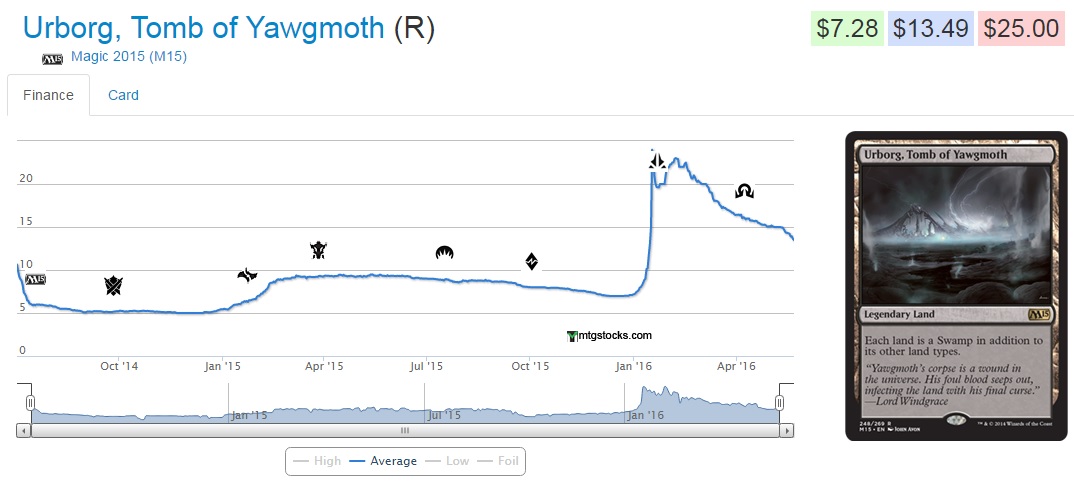
On 12/22/15, Sheridan Lardner mentioned the interaction between Urborg, Tomb of Yawgmoth and Eye of Ugin. At the time Oath of the Gatewatch wasn't out yet and the big play was to exile a card with Relic of Progenitus and then Wasteland Strangler their early creature. With the addition of OGW we'd see the more powerful option of turn-two Thought-Knot Seer, but that wasn't known at the time. What is important is that when Sheridan's article went up on QS, we had 13 days to react before it spiked.
On 08/05/14, Sylvain Lehoux highlighted Urborg's potential to rebound. At this time it was sitting under $6.
One could have easily looked up Urborg's price before the M15 reprint and realize there was a lot of previous demand. It's the only land in the game that turns other lands into full-on duals, and as such is particularly powerful and unique.
This was one of the few rares in M15 that nobody around me wanted to trade, which I should have used as a solid indicator to pick up a lot of copies. Sadly, I didn't go deep on this one and when it spiked I only had an extra three copies to trade off. Not terrible, but I didn't aggressively try and pick up extra copies, thinking I had more time.
Chord of Calling
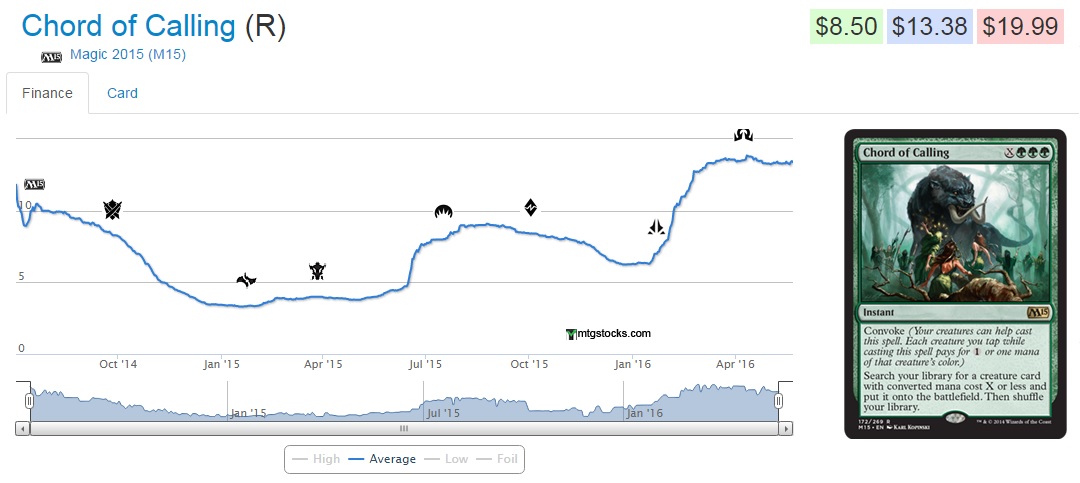
I can happily say that I called this one back at its floor on 01/11/15 and re-emphasized it again on 01/25/15. Corbin Hosler mentioned it on 01/22/15.
Anytime you see a card go from $30+ to $3.50 you really want to look at the reason. If it's been banned from its main format, it might not be a wise investment. But when the drop is solely due to a reprint, it's playable in a competitive format and popular in Commander, it's definitely worth considering. All the points I discussed in those two articles from about a year and a half ago are still valid.
Both Chord and Urborg dropped heavily when they were reprinted in M15, which as a core set tended to be less desirable for drafting and cracking packs. This meant there would likely be fewer copies in the market, and when the market dried up or the inevitable increase in demand wasn't met, they would rise in value.
Current Picks for Undervalued Cards
Day's Undoing
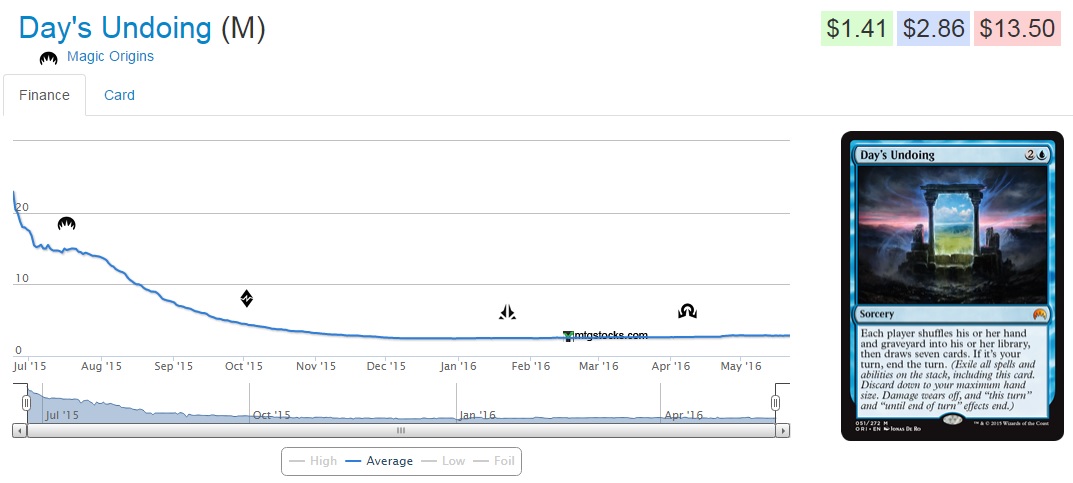
Personal investment: I currently have 5 copies in my speculation box.
I didn't play during the days of the original Timetwister and I know that to many people it's no longer part of the Power 9 (having been replaced by Time Vault). However, draw-sevens are incredibly powerful in Magic. Previously WoTC has tried to remake Timetwister in safer forms. Before Day's Undoing we got Time Reversal, which has yet to really make its mark, and before that we got Unexpected Windfall, which ended up being so broken it's banned in Legacy.
Day's Undoing looks like it might be closer to Unexpected Windfall then Time Reversal, if only because it's exactly Timetwister with the "end the turn" caveat at the end. While this definitely tones it down a bit, there are ways to break it.
Some of the most obvious are ways to give it flash like Quicken, Leyline of Anticipation or Vedalken Orrery. It could also be used in a deck that can use the new cards during the opponent's turn (perhaps a new take on the old Seismic Swans deck).
Of my suggestions today, I expect this one will probably see the most pushback from readers. I see this card as having a ton of potential, though, especially if you can find a way to make it more beneficial to you (the caster) than to the opponent.
Elesh Norn, Grand Cenobite
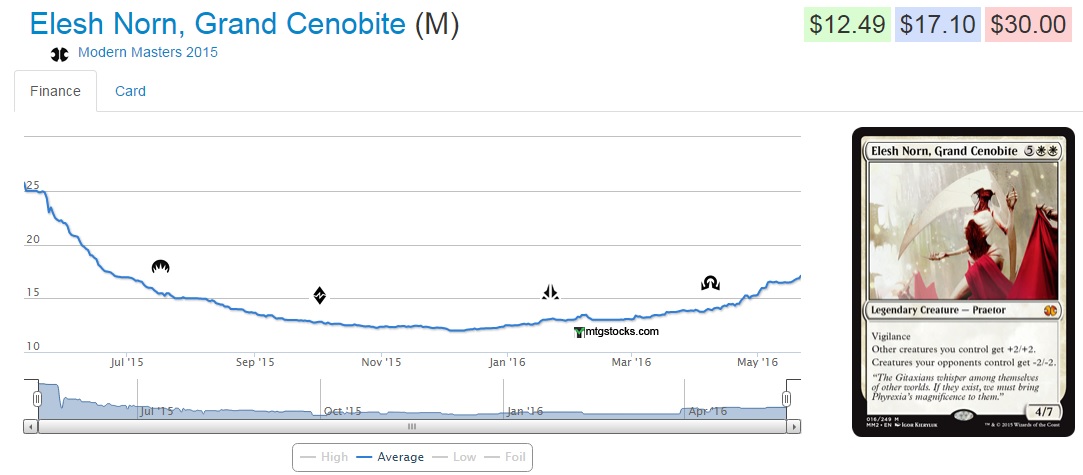
Personal investment: 14 copies
Elesh Norn, Grand Cenobite used to be a $33 dollar card until it was reprinted in Modern Masters 2015. It hit a low right under $13. I called this as a good spec on 09/15/15 and again on 11/11/15. Matt Lewis and Sylvain Lehoux also called it in their MTGO Market Report from 06/24/15, although her paper price was still a bit higher then than when I started buying my copies later in September.
The point is that we had all seen the card perform in eternal formats and the ability is incredibly powerful. It's the #1 reanimation target in Modern, and #2 in Legacy (behind Disciple of Griselbrand). It's currently on a slow and steady rise, but if a Gifts Ungiven deck in Modern were to ever win a major event, this card would likely jump immediately.
Thoughtseize

Personal investment: 23 copies
Thoughtseize was the second most expensive card in Modern for a couple of months. Then it was spoiled in Theros and consequently the value of the original dropped dramatically.
The ability is incredibly powerful and to some decks the life loss is irrelevant (typically very fast decks or ones that can regain life easily). It was a powerhouse in Standard, both the first time around and again in 2014 as one of the backbones of Mono-Black Devotion.
Thoughtseize is currently at an all-time low. That's partly because Modern has so many powerful fast aggro decks that can punish additional life loss, and Inquisition of Kozilek can hit a good number of the same cards. However, that means that the current price is heavily dictated by the current Modern metagame---which we all know can change.
Vendilion Clique
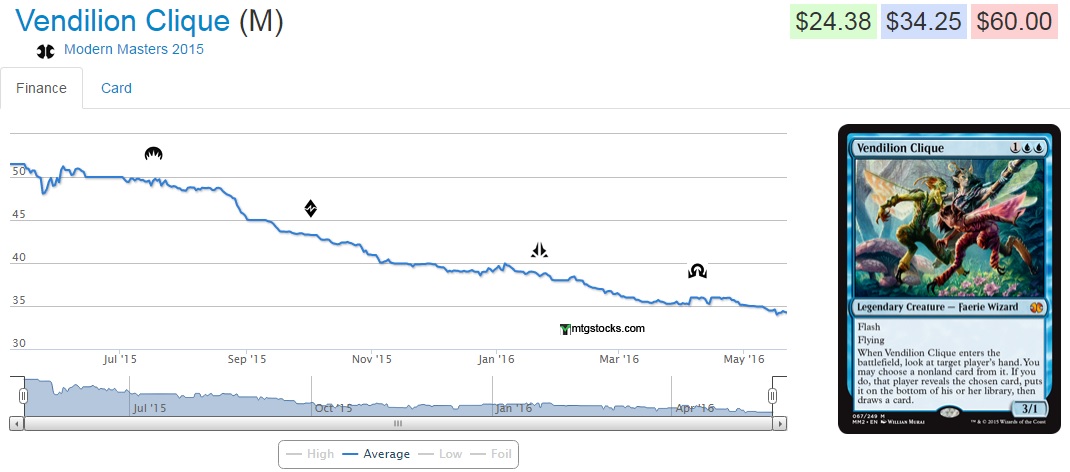
Personal investment: 7 copies (including 4 foils, which are pretty cheap)
Vendilion Clique is another card whose current price is heavily influenced by the current Modern metagame. Even though it showed up in the original Modern Masters it still reached a price tag of right around $75 back in late October 2014. While the second reprinting in Modern Masters 2015 helped drop the price further, the shift in the Modern metagame away from blue tempo and/or control decks is the real reason this card is at its current low.
Recently we've seen a resurgence in Jeskai Control thanks to Nahiri, the Harbinger, a one-card combo that tutors out Emrakul, the Aeons Torn to annihilate the opponent. We haven't seen a successful Jeskai deck in Modern since way back in 2014 when the deck was basically Snapcaster Mage, Restoration Angel, a few V. Cliques and a bunch of burn and counter spells. These new versions finally have a better closer than chaining a bunch of burn spells and getting in nickel-and-dime damage with Snapcasters or Restoration Angels.
This could very well mean a resurgence in Vendilion Clique as it is potent disruption and a decent clock against other control decks. Don't be surprised when this one starts trending back up again.


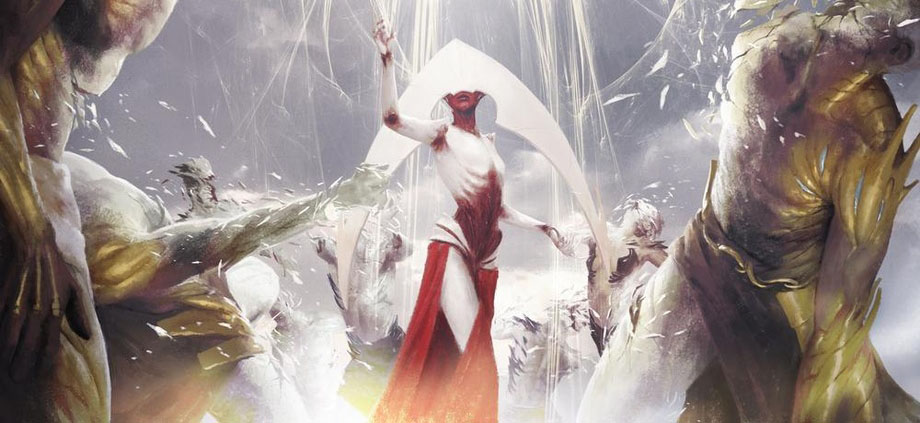



I have 16 copies of Day’s Undoing, and similarly think this card will eventually find a home. We shall see. Nice read.
Edit: foil copies
Nice…I think those have a lot of potential (especially if they ever find a home in legacy). Also the card itself is beautiful.
Here’s a link to a tweet from Raphael Levy regarding a Day’s Undoing, Jeskai Ascendency, Affinity hybrid. A very interesting deck of unknown power level.
https://twitter.com/hahamoud/status/7343333110535…
https://twitter.com/hahamoud/status/7343333110535…
Ok, the link is not working because it being cut off for some reason by the comment part of WordPress. Just go to Raphael Levy’s twitter account and look at the top tweet.